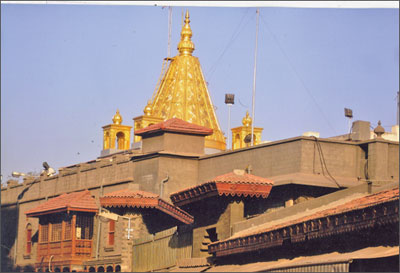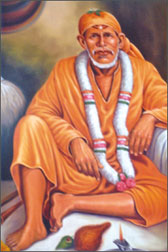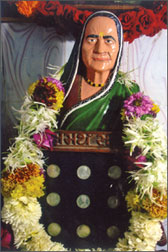|
A trip to Shirdi:
City of the simple saint of Hindus and Muslims
by Dr. Nimal SEDERA
|

The main building at the Shirdi Ashram
|
It is 92 years after Shirdi Sai Baba's Samadhi, An average of twenty
five thousand devotees come to his Samadhi daily offering red roses.
In most of the Hindu houses and business places in India you are sure
to spot the picture of their much loved saint "Shirdi Sai Baba". He is
considered as an incarnation of God. In appearance he stands quite
different to many other gods venerated by the Hindus. Shirdi Baba
contributes to the unity between the Hindus and the Muslims in India, He
is a saint accepted by both communities.
Shirdi Baba lived in the 19th century and died on October 15, 1918 in
Shirdi.
"Shirdi" is in the state of Maharashtra, in the district of Ahamed
Nagar about 185 kilometres west of beach on the Ahead Nagar-Manmade
road.
Having read and heard of Shirdi Sai Baba for several years we set on
the journey of visiting Shirdi on February 26, 2010 and we were at the
Dharmawaram railway station to board the train. We were five in the
group. Raju our Indian friend who is a regular visitor to Shirdi was the
captain of the team. My wife Swarna, another Sri Lankan friend, Pema and
her son Saman were the other members of the team.

Shridi Sai Bab |

Lakshmi statue with the
original nine coins |
Dharmawaram was an unusually clean railway station very neatly
painted and with comfortable clean seating and with good landscaped
garden. The train to Shirdi that was coming from Bangalore was also
something very special. This train was entirely air-conditioned and with
sleeping berths to every passenger. The duration of the journey was
around fifteen hours. The train journey was so interesting and fun.
Raju's wife had packed the dinner for us, and has added so much stuff to
munch and food stuff was continuously brought to the compartment from
the buffet of the train. We cultivated a friendship with all the
passengers around us and we had many to talk with. We climbed to our
beds by ten in the night and had a sound sleep until morning sometimes
feeling that you are being rocked in a cradle.
The train was in Shirdi about five minutes ahead of the schedule time
and almost about three hundred passengers alighted at this station,
everyone was visiting Shirdi.
It was the three wheelers doing the job of taking the passengers to
Shirdi temple or to the hotels.
They pack the vehicle with the maximum number of passengers charging
each one 20 rupees. We were also squeezed into a Bajaj and prayed to be
freed. We paid two hundred rupees and the five of us were taken in a
separate vehicle.
The short journey of about three miles was like hell with bad road
and full of dust. the three wheelers were racing on the gravel road and
dust waves covered the vehicle so much so that breathing was difficult.
The small town growing up with several new buildings is entirely
based on the large number of people coming to pay respect to the Samadhi
of Shirdi Baba. Hotels, travel, transportation, the flower business and
the souvenirs, were all a part of Shirdi Baba worship.
The premises near the Samadhi were full of people selling red roses.
It is mostly red roses that are offered at the Samadhi. The walk to the
Samadhi has been made comfortable by the organisers erecting a strong
canopy and well fenced so that people have to walk one behind the other.
The ladies and gents walked in the same queue. The devotees short
slogans in praise of Shirdi Sai.
The average number of devotees visiting the Samadhi of Shirdhi Sai
Baba for a day is above twenty five thousand... At festival times is
some times exceeds a hundred thousand people. The morning darshan begins
at 4.00 am and the gates close at night at 10.00 pm.
With bunches of red roses in hand we arrived at the Samadhi after one
hour of walking in the queue and occasionally being pushed from behind.
Suddenly the Samadhi in white marble began to appear and the
restlessness of the people began to feel. The statue of Shirdi Baba done
in white, stood Beneath the Samadhi.
No one gets the chance to remain at the Samadhi more than a few
seconds. As you place the flowers the security officers direct you to
the exit. Our friend Raju said that we have come from Sri Lanka and be
given a few more seconds. The security obliged and we remained almost
two to three minutes near the Samadhi. On all the three days we stayed
in Shirdi we went for all the morning and evening darshanas. We were
able to obtain special passes showing our passports to the office
counter. This is a special privilege arranged for foreign devotees.
The Samadhi premise is a well spread and well managed by the Sai
Trust and kept clean in spit of the large numbers visiting the place
daily. The key places other than the Samadhi to be visited are the
building where the fire lit by Shirdi Baba is preserved to date. It is
from this fire Shirdi Baba gave the "Udi" meaning ash to the devotees to
help in their problems.
Shirdi Sai sat on a granite rock in his mosque, when meeting the
devotees. This rock is preserved in the exact place where it was.
Lakshmi Bai Shindi was a close devotee and she often offered food to
him. The small house of Lakshmi is preserved and the wooden pillar where
the Shirdhi Sai leaned against when seated for meals at this house is
being well protected.
On the last day of his life Shirdi Baba gifted this lady with nine
coins and said the nine coins resemble the nine key principles of his
teachings and reminded them to her. The nine points were I, shed egoism
2, rid jealousy 3, do untiring service 4, reduce worldly desires 5, have
faith in the Guru 6, maintain a peaceful nature 7, desire to know the
truth 8, Be away from envy 9, refrain from boasting. These nine coins
given to her are framed and displayed in her house.
He served his devotees even on his last day and in his late hour
curing a blood vomiting person and instructed about his funereal and of
the construction of the Samadhi through dreams to his devotees and
requested that the arathi pooja be performed to his dead body. Limbs of
the dead body never became stiff. Incidentally Shirdi Baba could remove
his limbs and fix them back. There is no trace of Shirdi Sai's birth
place or of an exact date he was first seen in Shirdi. His dress was a
long yellow frock which stretched below the knees and stood about a foot
above the ankles. He wore a cloth hat just to cover the top of his head
and appeared more like a Muslim. In his teaching he attempted to
reconcile Hinduism and Islam.
|

